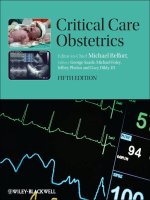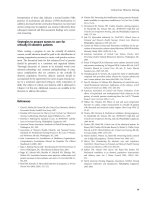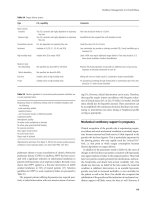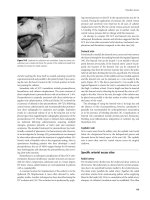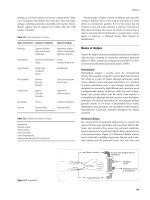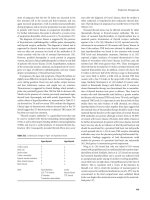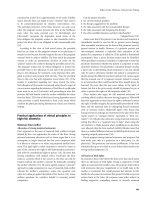Critical care medicine - part 1 ppsx
Bạn đang xem bản rút gọn của tài liệu. Xem và tải ngay bản đầy đủ của tài liệu tại đây (80.73 KB, 15 trang )
Contents
Advanced Cardiac Life Support 5
Critical Care Patient Management 15
Critical Care History and Physical Examination 15
Critical Care Physical Examination 15
Admission Check List 16
Critical Care Progress Note 17
Procedure Note 17
Discharge Note 18
Fluids and Electrolytes 18
Blood Component Therapy Fibrillation 36
Hypertensive Emergency 41
Ventricular Arrhythmias 44
Torsades de Pointes 44
Acute Pericarditis 45
Pacemakers 46
Pulmonary Disorders 49
Orotracheal Intubation 49
Nasotracheal Intubation 50
Ventilator Management 51
Inverse Ratio Ventilation 52
Ventilator Weaning 52
Pulmonary Em 69
Pericardiocentesis 69
Hematologic Disorders 71
Transfusion Reactions 71
Disseminated Intravascular Coagulation 72
Thrombolytic-associated Bleeding 73
Infectious Diseases 75
Bacterial Meningitis 75
Pneumonia 79
Pneumocystis Carinii Pneumonia 83
Antiretroviral Therapy and Opportunistic Infections in AIDS 85
Sepsis 87
Peritonitis 91
Gastroenterology 93
Upper Gastrointestinal Bleeding 93
Variceal Bleeding 94
Lower Gastrointestinal Bleeding 96
Acute Pancreatitis 99
Hepatic Encephalopathy 102
Toxicology 105
Poisoning and Drug Overdose 105
Toxicologic Syndromes 106
Acetaminophen Overdose 106
Cocaine Overdose 108
Cyclic Antidepressant Overdose 109
Digoxin Overdose 109
Ethylene Glycol Ingestion 110
Gamma-hydroxybutyrate Ingestion 111
Iron Overdose 111
Isopropyl Alcohol Ingestion 112
Lithium Overdose 112
Methanol Ingestion 113
Salicylate Overdose 113
Theophylline Toxicity 114
Warfarin (Coumadin) Overdose 115
Neurologic Disorders 117
Ischemic Stroke 117
Elevated Intracranial Pressure 120
Status Epilepticus 122
Endocrinologic and Nephrologic Disorders 125
Diabetic Ketoacidosis 125
Acute Renal Failure 127
Hyperkalemia 130
Hypokalemia 133
Hypomagnesemia 134
Hypermagnesemia 135
Disorders of Water and Sodium Balance 136
Hypophosphatemia 140
Hyperphosphatemia 141
Commonly Used Formulas 142
Commonly Used Drug Levels 142
Index 144
Advanced Cardiac Life Support
EMERGENCY CARDIAC CARE
If wi tnessed arrest, give
precord ial thump and
check pulse. If absent,
continue CP R
Assess Re spo nsiveness
Unresponsive
Call for code team and De fibr illato r
Assess breathing (op en the airway, look,
liste n an d feel for breathing)
If Not Bre ath ing,
give two slow b reaths.
Assess Cir cula tion
PULSE NO PULSE
Initia te CPR
Give oxygen by bag mask
Secure IV access
Dete rmine proba ble e tiol ogy of arrest
based on histo ry, physical exam, car diac
monitor, vital signs, and 12 lead ECG.
Ven tricular
fibrillation/tach ycardia
(VT/VF) p rese nt on
monitor?
Hypo ten sion /shock,
acute p ulmonary
edema .
Go to fig 8
NO YES
Intu bate
Confirm tube pla ceme nt
Dete rmine rhythm and
cause.
VT/VF
Go to Fig 2
Arrh ythmia
Brad ycardia
Go to Fig 5
Tachycardia
Go to Fig 6
Electrical A ctivity?
YES
NO
Pulseless e lectrical activity
Go to Fig 3
Asystole
Go to Fig 4
Fig 1 - Algorithm for Adult Emergency Cardiac Care
VENTRICULAR FIBRILLATION AND PULSELESS
VENTRICULAR TACHYCARDIA
Con tinue CPR
Persist ent or
recurrent V F/VT
Epinep hrine 1 mg
IV pu sh, re pe at
q3 -5min o r 2 m g in
10 ml NS via ET t ube
q3 -5min or
Vasopressin 40 U I VP x
1 do se o nly
Def ibrillate 360 J
Amiodarone (Cordarone) 300 mg IV P or
Lido ca in e 1. 5 mg /k g IV P, an d repe a t q 3-5 min, u p t o to ta l max o f 3 mg/ kg or
Magnesium s ulf at e (if Tors ade de poin te s or hypo ma gn es emic ) 2 gms IV P or
Procaina mide (if ab ove are in ef fec tive ) 3 0 mg/min I V inf u sion to ma x 17 mg/kg
Continue CPR
Secure IV access
In tubat e if no respo nse
Def ib rillate immediately, u p to 3 times at 20 0 J, 20 0-30 0 J, 36 0 J.
Do not de la y defibrillation
Return of
spo nt ane ou s
circulation
Pu lseless E lectrical
Act ivity
Go to Fig 3
Monit or vital sign s
Su pp or t a irway
Su pp or t b re athing
Provide me dications appropriate for bloo d
pre ssure, hea rt rate, and rhythm
Asse ss Airway, Breath ing, Circulation, Diffe rent ial Diagnosis
Ad min ister CPR u ntil d efibrillato r is ready (p recordia l thu mp if witn esse d arrest )
Ve ntricular Fibrillation or Ta chycardia presen t on defibrillator
Asyst ole
Go to Fig 4
Check pu lse and Rhythm
Co nt inue CP R
De fibrilla te 36 0 J, 30-60 seconds af te r ea ch dose of me dication
Repe at amio daro ne (Cord arone ) 15 0 mg IV P prn (if re urrent VF/ VT) , up to ma x
cu mulative do se of 22 00 mg in 24 ho urs
Cont in ue CP R. Ad minist er s odium bicarbonate 1 mEq/k g I VP if long arres t period
Repe at patt ern o f d rug -sho ck, drug-sho ck
Note: Epinephrine, lidocaine, atropine may be given via endotracheal tube at
2-2.5 times the IV dose. Dilute in 10 cc of sa line.
After each intraveno us dos e, give 20-30 mL bolus of IV f luid and elevate
extremity.
Fig 2 - Ventricular Fibrillation and Pulseless Ventricular Tachycardia
PULSELESSELECTRICALACTIVITY
PulselessElectrical Activity Includes:
Electromechanical dissociation (EMD)
Pseudo-EMD
Idioventricularrhythms
Ventricular escaperhythms
Bradyasystolic rhythms
Postdefibrillation idioventricular rhythms
Epinephrine 1.0 mgIVbolus q3-5min, or high dose
epinephrine0.1 mg/kg IVpushq3-5min; maygivevia
ET tube.
Continue CPR
If bradycardia (<60beats/min), giveatroprine 1 mgIV, q3-5
min, up to total of 0.04 mg/kg
Consider bicarbonate, 1mEq/kg IV(1-2amp, 44 mEq/amp),
if hyperkalemiaor other indications.
Determine differential diagnosis and treat underlying cause:
Hypoxia (ventilate)
Hypovolemia (infuse volume)
Pericardial tamponade (performpericardiocentesis)
Tension pneumothorax (per formneedle decompression)
Pulmonary embolism (thrombectomy, thrombolytics)
Drug overdose with tricyclics, digoxin, beta, or calciumblockers
Hyperkalemia or hypokalemia
Acidosis (give bicarbonate)
Myocardial infarction (thrombolytics)
Hypothemia(active rewarming)
Initiate CPR, secure IV access, intubate, assess pulse.
Fig 3 - Pulseless Electrical Activity
ASYSTOLE
Cont inue CPR. Confirmasystoleby
repositioning paddl es or by checking 2leads.
IntubateandsecureIVaccess.
Consider underlyingcause, suchas hypoxia,
hyperkalemia, hypokal emia, acidosis, drug
overdose, hypothermia. myocardial infarction.
Consider transcutaneous pacing(TCP)
Atropine1 mgIV, repeat q3-5minuptoatotal of
0.04 mg/kg; maygivevia ETtube.
Epinephrine1.0mgIVpush, repeat every 3-5 min;
maygi veby ETtube; highdoseepinephrine 0.1
mg/kg IVpushq5min(1:1000sln).
Consider bicarbonate1mEq/kg(1-2amp) if
hyperkalemia, acidosis, tricyclicoverdose.
Consider terminationof efforts.
Fig4-Asystole
BRADYCARDIA
No
Yes
Ye sNo
Assess Airway, Breathing, Circulation, Assess vital signs
Differential Diagnosis Reviewhistory
Secure airway and give oxygen Perform brief physical exam
Secure IVaccess Order 12-lead ECG
Attach monitor, pulse oximeter and
au tomaticsphygmomanometer
Too slow (<60 beats/min)
Bradycardia (<60beats/min)
Serious Signs or Symptoms?
If type II second or 3rd degree heartblock,
widecomplex escapebeats, MI/ischemia,
denervated heart (transplant),new bundle
branch block: Initiate Pacing(transcutanous
or venous)
If type I second degree heart block, give
at ropine 0.5-1. 0mg IV, repeat q5min, then
initiatepacing if bradycardia.
Dopamine 5-20 :g/kg per min IV infusion
Epinephrine 2-10 mcg/ min IV infusion
Isoproterenol 2-10 mcg/ min IVinfusion
Observe
Consider transcutaneouspacing or transvenous
pa cing.
Type II second degree AV heart
blockor third degree AV heart
block?
Fig 5-Bradycardia (withpatientnot in cardiac arrest).
No or borderline
Atrial fibr illation
Atrial flutter
TACHYCARDIA
Paroxysmal
supraventricular
narrow complex
tachycardia
(PSVT)
Wide-complex
tachycardia of
uncertain type
Ventricular
tachycardia (VT)
Torsade de pointes
(polymorphic VT)
Determine Etiology: Hypoxia, ischemia,
MI, pulmonary embolus,
hyperthyroidism, electrolyte abnomality,
theophylline, inotropes.
If uncertain if V tach,
give Adenosine 6
mg rapid IV push
over 1-3 sec
Amiodarone 150-
300 mg IV over 10-
20 min
Adenosine
12 mg, rapid IV
push over 1-3 sec
(may repeat once
in 1-2 min)
1-2 min
Adenosine
6 mg, rapid IV
push over 1-3 sec
1-2 min
Cardioversion of atrial fibrillation to sinus rhythm:
If less than 2 days and rate controlled:
Procainamide or amiodarone, followed by
cardioversion
If more than 2 days: Coumadin for 3 weeks;
control rate, start antiarrythmic agent, then
electrical cardioversion.
Control Rate: Diltiazem,verapamil, digoxin
esmolol, metoprolol
Yes
Assess Airway, Breathin g, Circulation, Differential Diagnosis
Assess Vitals, Secure Airway
Review histo ry and examine patien t.
Give 100 % oxygen , secure IV access.
Attach ECG monitor, pulse oximeter , blood pressure monitor.
Order 12-lead ECG, portable chest x-ray.
Correct underlying
cause: Hypokal-
emia, drug over-
dose (tricyc lic,
phenothiazine,
antiarrhythmic
class Ia, Ic, III)
UNSTABLE, with serious signs or symptoms?
Unstable includes, hypotension, heart failure, chest pain, myocardial
infarction, decreased mental status, dyspnea
IMMEDIATE CARDIOVERSION
Atrial flutter 50 J, paroxysmal supraventricular tachycardia
50 J, atrial fibrillation 100 J, monomorphic ventricular
tachycardia100 J, polymorphic V tach 200 J.
Premedicate with midazolam (Versed) 2-5 mg IVP when
possible.
Vagal maneuvers:
Carotid sinus
massage if no
bruits
Fig 6 Tachycardia
Ad eno s ine 12 m g , ra pid IV
p ush o ver 1 -3 se co nd s ( m ay
r ep eat o n c e i n 1-2 m i n ); m a x
to ta l 30 m g
Lidoca ine
1-1 .5 m g/ k g IV pu s h .
R ep ea t 0.5 -0. 75
m g /kg IV P q 5-1 0m in
to m a x to ta l 3 m g/ kg
M ag nesium 2-4 gm IV
over 5-1 0 m i n
Ove r drive pa cing
( cut an eo us or ve n ou s)
Iso pr o te re no l 2 -2 0 m cg/ m in
OR
Ph e nyto in 15 m g /kg IV at 5 0
mg /m in
OR
Lidoca i ne 1 .0-1 .5 m g /kg IV P
C ard io ve rsio n 20 0 J
Pro cainam ide 30
m g /m in IV to m ax
to ta l 17 m g /kg
Lidoca i ne 1 .0-1 .5 m g /kg IV P
Com p lex wid th ?
Nar row
Wide
If W o lf -Pa rkin son -W hit e
syn dr om e , give am io da r on e
(C or da r on e) 1 5 0-30 0 m g IV
over 10- 20 m i n
Pr o cain am id e
2 0-30 m g /m in, m a x to ta l 1 7 m g /kg ;
fo llow ed b y 2 -4 m g /m in in fu sion
If W P W , avo id ade nosine , bet a-
b lo cke rs, ca lc iu m -blo cker s, an d
digoxin
Syn ch ro nize d card io ve rsio n 10 0 J
N or m a l or e leva te d press ure
Low -un sta ble
Ve rap am il
2.5- 5 m g IV
15-30 m in
Ve rap am il
5 -1 0 m g IV
Con side r
Digo xin
Be ta b lo cke rs
Dilt iaze m
Ove rdr ive
pacing
Fi g 6 - Ta c h y c a r dia
Blo od Pressure ?
STABLE TACHYCARDIA
If ventricular rate is >150 beats/min, prepare for immediate cardioversion.
Treatment of Stable Patients is based on Arrhythmia Type:
Ventricular Tachycardia:
Procainamide (Pronestyl) 30 mg/min IV, up to a total max of 17 mg/kg,
or
Amiodarone (Cordarone) 150-300 mg IV over 10-20 min, or
Lidocaine 0.75 mg/kg. Procainamide should be avoided if ejection
fraction is <40%.
Paroxysmal Supraventricular Tachycardia: Carotid sinus pressure (if
bruits absent), then adenosine 6 mg rapid IVP, followed by 12 mg rapid
IVP x 2 doses to max total 30 mg. If no response, verapamil 2.5-5.0 mg
IVP; may repeat dose with 5-10 mg IVP if adequate blood pressure; or
Esmolol 500 mcg/kg IV over 1 min, then 50 mcg/kg/min IV infusion, and
titrate up to 200 mcg/kg/min IV infusion.
Atrial Fibrillation/Flutter:
Ejection fraction $40%: Diltiazem (Cardiazem) 0.25 mg/kg IV over 2
min; may repeat 0.35 mg/kg IV over 2 min prn x 1 to control rate. Then
give procainamide (Pronestyl) 30 mg/min IV infusion, up to a total max
of 17 mg/kg
Ejection fraction <40%: Digoxin 0.5 mg IVP, then 0.25 mg IVP q4h x 2
to control rate. Then give amiodarone (Cordarone) 150-300 mg IV over
10-20 min.
Stable tachycardia with serious signs and
symptoms related to the tachycardia. Patient
not in cardiac arrest.
Check oxygen saturation, suction device,
intubation equipment. Secure IV access
Synchronized cardioversion
Atrialflutter 50 J
PSVT 50 J
Atrial 100 J
Monomorphic V-tach 100 J
Polymorphic V tach 200 J
Premedicate whenever possible with Midazolam (Versed)
2-5 mg IVP or sodium pentothal 2 mg/kg rapid IVP
Fig 7 -Stable Tachycardia (not in cardiac arrest)
HYPOTENSION, SHOCK, ANDACUTE PULMONARY EDEMA
Sys t o li c B P
7 0 - 1 0 0 m m H g
D o p a m ine 2. 5 - 2 0
:
g/k g pe r m in I V
( a dd no r e pin e p h r in e
if do p a m ine i s > 2 0
:
g/k g pe r m in)
N o r e p inep h r in e 0. 5-
30
:
g/ m in IV or
D opam in e 5-2 0
:
g/ kg
per m in
Bra d yc a r d ia
Go t o F ig 5
Systoli c B P >100 m m Hg
an d dia sto lic BP n orm al
S y s toli c B P
< 70 m m H g
Diasto lic B P >11 0 mm Hg
D o b u t a m i n e 2.0-2 0
:
g/ k g p e r m in I V
F u r o s e m id e IV 0 .5 -1.0 m g /kg
M o r p hi ne I V 1-3 m g
N i t r o g l y c e r i n S L 0.4 m g t a b
q3 -5 m in x 3
Oxy g e n
Ta c h y ca r d ia
G o to F ig 6
D e ter m ine bl o o d p r es s u re
D e t e r m in e un de r ly ing c aus e
Hy p o v o l e m ia
P u m p Fa i lur e
B ra d y car d i a o r T a ch ycar d ia
A d m inis te r F luid s, B lo o d
C ons ider v a s opr e s s o r s
A p p ly h e m o s ta s is ; tr ea t
und er ly in g p r o blem
I f is c h em ia an d h ype rte n s ion:
N itr ogly c er in 10 -20
:
g/min
IV , an d titr a te to e ffec t a n d /o r
N itr op r u s s ide 0. 1-5 .0
:
g/k g / m in IV
Signs and symptoms of congestiveheart failure, acute pulmonary edema.
Assess ABCD's, secure airway, administer oxygen; secureIVaccess. Monitor ECG, pulse oximeter,
blood pressure, order 12-lead ECG, portable chest X-ray
Check vital signs, review history, and examine patient. Determine differential diagnosis.
Fig 8- Hypotension, Shock, and AcutePulmonaryEdema
14 Critical Care History and Physical Examination
Critical Care History and Physical Examination 15
Critical Care Patient Management
T. Scott Gallacher, MD, MS
Critical Care History and Physical Examination
Chief complaint: Reason for admission to the ICU.
History of present illness: This section should included pertinent chronological
events leading up to the hospitalization. It should include events during
hospitalization and eventual admission to the ICU.
Prior cardiac history: Angina (stable, unstable, changes in frequency),
exacerbating factors (exertional, rest angina). History of myocardial infarction,
heart failure, coronary artery bypass graft surgery, angioplasty. Previous
exercise treadmill testing, ECHO, ejection fraction. Request old ECG, ECHO,
impedance cardiography, stress test results, and angiographic studies.
Chest pain characteristics:
A. Pain: Quality of pain, pressure, squeezing, tightness
B. Onset of pain: Exertional, awakening from sleep, relationship to activities
of daily living (ADLs), such as eating, walking, bathing, and grooming.
C. Severity and quality: Pressure, tightness, sharp, pleuritic
D. Radiation: Arm, jaw, shoulder
E. Associated symptoms: Diaphoresis, dyspnea, back pain, GI symptoms.
F. Duration: Minutes, hours, days.
G. Relieving factors: Nitroclycerine, rest.
Cardiac risk factors: Age, male, diabetes, hypercholesteremia, low HDL,
hypertension, smoking, previous coronary artery disease, family history of
arteriosclerosis (eg, myocardial infarction in males less than 50 years old,
stroke).
Congestive heart failure symptoms: Orthopnea (number of pillows), paroxys-
mal nocturnal dyspnea, dyspnea on exertional, edema.
Peripheral vascular disease symptoms: Claudication, transient ischemic
attack, cerebral vascular accident.
COPD exacerbation symptoms: Shortness of breath, fever, chills, wheezing,
sputum production, hemoptysis (quantify), corticosteroid use, previous
intubation.
Past medical history: Peptic ulcer disease, renal disease, diabetes, COPD.
Functional status prior to hospitalization.
Medications: Dose and frequency. Use of nitroglycerine, beta-agonist, steroids.
Allergies: Penicillin, contrast dye, aspirin; describe the specific reaction (eg,
anaphylaxis, wheezing, rash, hypotension).
Social history: Tobacco use, alcohol consumption, intravenous drug use.
Review of systems: Review symptoms related to each organ system.
Critical Care Physical Examination
Vital signs:
Temperature, pulse, respiratory rate, BP (vital signs should be given in
ranges)
Input/Output: IV fluid volume/urine output.
16 Admission Check List
Special parameters: Oxygen saturation, pulmonary artery wedge pressure
(PAWP), systemic vascular resistance (SVR), ventilator settings, impedance
cardiography.
General: Mental status, Glasgow coma score, degree of distress.
HEENT: PERRLA, EOMI, carotid pulse.
Lungs: Inspection, percussion, auscultation for wheezes, crackles.
Cardiac: Lateral displacement of point of maximal impulse; irregular rate,,
irregular rhythm (atrial fibrillation); S3 gallop (LV dilation), S4 (myocardial
infarction), holosystolic apex murmur (mitral regurgitation).
Cardiac murmurs: 1/6 = faint; 2/6 = clear; 3/6 - loud; 4/6 = palpable; 5/6 = heard
with stethoscope off the chest; 6/6 = heard without stethoscope.
Abdomen: Bowel sounds normoactive, abdomen soft and nontender.
Extremities: Cyanosis, clubbing, edema, peripheral pulses 2+.
Skin: Capillary refill, skin turgor.
Neuro
Deficits in strength, sensation.
Deep tendon reflexes: 0 = absent; 1 = diminished; 2 = normal; 3 = brisk; 4 =
hyperactive clonus.
Motor Strength: 0 = no contractility; 1 = contractility but no joint motion; 2 =
motion without gravity; 3 = motion against gravity; 4 = motion against
some resistance; 5 = motion against full resistance (normal).
Labs: CBC, INR/PTT; chem 7, chem 12, Mg, pH/pCO
2
/pO
2
. CXR, ECG,
impedance cardiography, other diagnostic studies.
Impression/Problem list: Discuss diagnosis and plan for each problem by
system.
Neurologic Problems: List and discuss neurologic problems
Pulmonary Problems: Ventilator management.
Cardiac Problems: Arrhythmia, chest pain, angina.
GI Problems: H2 blockers, nasogastric tubes, nutrition.
Genitourinary and Electrolytes Problems: Fluid status: IV fluids, electrolyte
therapy.
Hematologic Problems: Blood or blood products, DVT prophylaxis.
Infectious Disease: Plans for antibiotic therapy; antibiotic day number, culture
results.
Endocrine/Nutrition: Serum glucose control, parenteral or enteral nutrition, diet.
Admission Check List
1. Call and request old chart, ECG, and x-rays.
2. Stat labs: CBC, chem 7, cardiac enzymes (myoglobin, troponin, CPK), INR,
PTT, C&S, ABG, UA, cardiac enzymes (myoglobin, troponin, CPK).
3. Labs: Toxicology screens and drug levels.
4. Cultures: Blood culture x 2, urine and sputum culture (before initiating
antibiotics), sputum Gram stain, urinalysis.
5. CXR, ECG, diagnostic studies.
6. Discuss case with resident, attending, and family.
Critical Care Progress Note 17
Critical Care Progress Note
ICU Day Number:
Antibiotic Day Number:
Subjective: Patient isawake and alert. Note any events that occurred overnight.
Objective: Temperature, maximum temperature, pulse, respiratory rate, BP, 24-
hr input and output, pulmonary artery pressure, pulmonary capillary wedge
pressure, cardiac output.
Lungs: Clear bilaterally
Cardiac: Regular rate and rhythm, no murmur, no rubs.
Abdomen: Bowel sounds normoactive, soft-nontender.
Neuro: No local deficits in strength, sensation.
Extremities: No cyanosis, clubbing, edema, peripheral pulses 2+.
Labs: CBC, ABG, chem 7.
ECG: Chest x-ray:
Impression and Plan: Give an overall impression, and then discuss impression
and plan by organ system:
Cardiovascular:
Pulmonary:
Neurological:
Gastrointestinal:
Infectious:
Endocrine:
Nutrition:
Procedure Note
A procedure note should be written in the chart when a procedure is performed.
Procedure notes are brief operative notes.
Procedure Note
